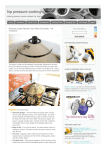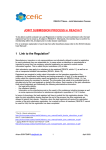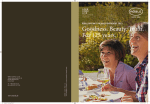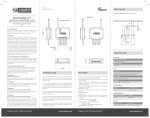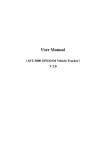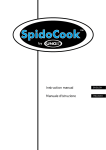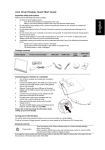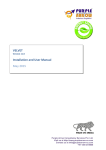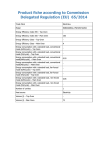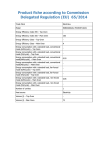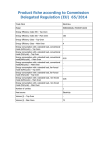Download Guidelines accompanying Regulation (EU) No 65/2014 with regard
Transcript
EUROPEAN COMMISSION DIRECTORATE-GENERAL FOR ENERGY Directorate C - Renewables, Research and Innovation, Energy Efficiency C.3 - Energy efficiency Guidelines accompanying Regulation (EU) No 65/2014 with regard to the energy labelling of domestic ovens and range hoods, and Regulation (EU) No 66/2014 with regard to ecodesign requirements for domestic ovens, hobs and range hoods 2 Contents 1 INTRODUCTION ....................................................................................................... 3 2 SCOPE......................................................................................................................... 4 2.1 3 ECODESIGN AND ENERGY LABELLING REQUIREMENTS ............................ 5 3.1 3.2 4 Types of domestic cooking appliances not covered by the Regulations ........... 4 2.1.1 Ovens without adjustable temperature ................................................ 4 2.1.2 AGA cookers ....................................................................................... 4 2.1.3 Other appliances (such as fondue sets, pancake makers, woks, mini-woks or tajine dishes).................................................................. 4 2.1.4 Recirculation hoods ............................................................................. 5 Responsibilities.................................................................................................. 5 Stages and requirements .................................................................................... 2 3.2.1 Timetable ............................................................................................. 2 3.2.2 Placing on the market .......................................................................... 3 3.2.3 Ovens – Information requirements (Regulation 66/2014, Annex I.2.1, Table 4) ........................................................................... 3 3.2.4 Labelling for multiple combination hoods .......................................... 4 MEASUREMENT METHODS AND CONFORMITY ASSESSMENT................... 4 4.1 4.2 4.3 4.4 Best Efficiency Point (BEP) measurement ........................................................ 4 Range hoods with mood lights .......................................................................... 5 Range hoods without lights ............................................................................... 5 Time calculation for maximum boost air volume ............................................. 5 4.5 OTHER RELATED LEGISLATION: STANDBY REGULATION ......................... 5 2 1 INTRODUCTION The Ecodesign and Energy Labelling Regulations (respectively No 66/2014 and No 65/2014, the Regulations) for domestic cooking appliances were published in January 2014 and will be applicable from 2015 onwards. These Regulations establish minimum requirements and an energy labelling scheme for the products in their scope. These Guidelines aim to summarise the most relevant information from the Regulations in a readable format to give all relevant actors including SMEs an introduction to the subject matter and answer their most common questions. These Guidelines follow the structure of the regulations, starting with the scope. They summarise the Ecodesign and Energy Labelling requirements; the responsibilities for the manufacturers, suppliers and dealers; and the timetable. Finally, the Guidelines cover topics related to measurement methods and harmonized standards, and close with additional resources for further information. The document aims to help a number of groups, including industry and public authorities, to apply the regulations and requirements in practice. These Guidelines are not intended to provide a binding interpretation of EU law as this is the sole competence of the European Court of Justice. They are intended to be used only for facilitating the implementation of the Regulations. They are not intended to replace the Regulations or to provide “interpretation” beyond their intent. The Guidelines are without prejudice to the position the Commission might take should an issue arise in a procedure before the European Court of Justice. The Regulations The Commission has published the following regulations concerning domestic ovens, hobs and range hoods: Commission Delegated Regulation (EU) No 65/2014 of 1 October 2013 supplementing Directive 2010/30/EU with regard to the energy labelling of domestic ovens and range hoods Commission Regulation (EU) No 66/2014 of 14 January 2014 implementing Directive 2009/125/EC with regard to ecodesign requirements for domestic ovens, hobs and range hoods It is important to note that the new Energy Labelling Commission Delegated Regulation (EU) No 65/2014 repeals the Commission Directive of 2002 regarding energy labelling of household electric ovens as of 1 January 2015. Revision Both regulations are due to be reviewed by 2021. Key topics to be assessed during the reviews include: potential requirements to enhance the recovering and recycling; requirements regarding durability and lifetime; requirements regarding odour removal; and the inclusion of professional and commercial appliances. 3 2 SCOPE The scope of the regulations on Energy Labelling and Ecodesign differs slightly. Both regulations cover domestic electric and gas ovens (including those incorporated in cookers) and domestic electric range hoods including when sold for non-domestic purposes. However, the scope of the Ecodesign regulation is wider than that of the Energy Labelling as it also covers domestic electric and/or gas hobs. 2.1 Types of domestic cooking appliances not covered by the Regulations Neither the Energy Labelling and Ecodesign regulations apply to appliances using energy sources other than electricity or gas, appliances with a microwave heating function, small, portable, heat storage or steam ovens. Furthermore, covered gas burners in hobs, outdoor cooking appliances and grills do not fall in the scope of the Ecodesign Regulation. 2.1.1 Ovens without adjustable temperature Article 2 (2) of the Regulations 65/2014 and 66/2014 defines a cavity of an oven as the enclosed compartment in which the temperature can be controlled. Therefore, it results that ovens without a feature that can control the temperature are outside the scope of this regulation. 2.1.2 AGA cookers These types of appliances which include ‘space heating’ and ‘cooking’ functions and can be fuelled with electricity, gas, oil or solid fuels are not covered by the scope of the ovens and hobs measures as: The 'space heating function' is outside the scope of the cooking appliances regulations. Concerning the ‘cooking function’ (ovens + hobs), appliances using energy sources other than electricity or gas are outside scope of the cooking appliances regulations. Regarding electric or gas ovens which are effectively 'heat storage ovens’, these are explicitly excluded from the scope of the cooking appliances regulations. Regarding gas hobs, they can be excluded from the scope of Regulation 66/2014 if they use ‘covered gas burners in hobs’ which are explicitly excluded from the scope of the Regulation and they do not include a specific control unit for hobs as required by the Regulation. Regarding electric hobs, they can be excluded if they use ‘heat storage’ and do not include a specific control unit for hobs as required by the Regulation. 2.1.3 Other appliances (such as fondue sets, pancake makers, woks, mini-woks or tajine dishes) Ecodesign Regulation (EU) No 66/2014 applies only to ovens, hobs and electric range hoods as defined in the Regulation. Specific appliances are excluded by Article 1(2) of the Regulation. Appliances which are not named in that list but do not come within the definition of 'oven', 'hob' or 'electric range hood' will not be within the scope of the Regulation. This means that all electrical hobs (solid hotplate, radiant or induction technology) that bear one or more cooking zones with a diameter >100mm, where the energy efficiency measurement according to the 'Measurements and calculations' Annex of the Regulation (EU) No 66/2014 can be carried out, are covered. Appliances on which 4 food is prepared without cookware but by positioning the food directly on the surface without a pan or a pot, for example to make toasts or crêpes, are not included. 2.1.4 Recirculation hoods In general hoods can be used in 'exhaust' or 'recirculation' mode. Hoods designed solely for recirculation that do not have an internal exhaust fan outlet similar to those of the 'exhaust' hoods are not in the scope of the regulations. 3 ECODESIGN AND ENERGY LABELLING REQUIREMENTS 3.1 Responsibilities The table below provides an overview of the responsibilities established by the Regulations for suppliers, manufacturers and dealers. Date 1.1.1.1. Responsibilities Manufacturers February 2015 August 2015 Ensure that cavities of domestic ovens comply with Energy Efficiency Index (EEI) < 146. Ensure that the energy efficiency of domestic hobs complies with the following limits: For electric hobs: energy consumption (EC) < 210 Wh/kg. For gas-fired hobs: energy efficiency (EE) > 53%. Ensure that domestic range hoods comply with the following limits: EEI of the hoods < 120 and Fluid Dynamic Efficiency (FDE) of the hoods > 3. Limit of air volume in boost mode: air flow ≤ 650 m3/h in a time as defined in Annex II of Regulation 66/2014. The range hoods which provide lighting of the cooking surface must have an average illumination of the lighting system > 40 lux. Provide information in the technical documentation, instructions and websites (incl. those of representatives and importers): On the measurement and calculation methods used to comply with the Ecodesign requirements. For the users on how they can reduce the total environmental impact of cooking. On non-destructive disassembly for maintenance, dismantling (especially related to the motor and batteries), recycling recovery and disposal at end-of-life. Ensure that domestic range hoods have “off mode”, “standby mode” and/or another condition offering low power consumption. Ensure that the afore-mentioned modes comply with the following limits when the product is connected to the power source: Power consumption in off-mode and standby mode (which offers only a reactivation function) ≤1,00W. Power consumption in standby mode (which offers a combination of reactivation function and information/ status display) ≤ 2,00W. 5 Date February 2016 Responsibilities Ensure that cavities of domestic ovens comply with Energy Efficiency Index (EEI) < 121. Ensure that the energy efficiency of domestic hobs complies with the following limits: For electric hobs: EC < 200 Wh/kg. For gas-fired hobs: EE > 54%. Ensure that domestic range hoods comply with the following limits: EEI of the hoods < 110. FDE of the hoods > 5. Ensure that the low power modes of domestic range hoods comply with the following limits: Power consumption in off-mode and standby mode (which offers only a reactivation function) ≤ 0,50W. Power consumption in standby mode (which offers a combination of reactivation function and information/ status display) ≤ 1,00W. Ensure that domestic range hoods be supplied with power management (or similar) function which switches the equipment into the aforementioned low power modes after the shortest possible time. This function must be activated before delivery. Ensure that the power management function of partially or fully automated range hoods switches the equipment into low power mode 1 minute after the motor and lighting are off. Ensure that cavities of domestic ovens comply with the following limits: Single-cavity ovens: EEI < 96. Multi-cavity ovens: EEI of one of the cavities < 96; EEI of the other cavities < 121. Ensure that the energy efficiency of domestic hobs complies with the following limits: For electric hobs: EC < 195 Wh/kg. For gas-fired hobs: EE > 55%. Ensure that domestic range hoods comply with the following limits: EEI of the hoods < 100. FDE of the hoods > 8. February 2017 August 2017 February 2019 1.1.1.2. Suppliers January 2015 Provide each domestic oven (incl. for each of its cavities) and range hood with a printed label in the required format and an electronic label for each product model available to dealers. Make available for domestic ovens and range hoods a product fiche and an electronic product fiche for each model available to dealers. Make the technical documentation available on request to MS authorities. 6 1 Date April 2015 Responsibilities 1.1.1.3. Include the energy efficiency class in any advertisement concerning a specific model of domestic oven and range hood disclosing energyrelated or price information. Include the energy efficiency class in any technical promotional material concerning a specific model of domestic oven and range hood describing specific technical parameters. Dealers January 2015 April 2015 Clearly display the energy label provided by suppliers on each model (incl. for each cavity of domestic ovens) presented at the point of sale. Include the energy efficiency class in any advertisement concerning a specific model of domestic oven and range hood disclosing energyrelated or price information. Include the energy efficiency class in any technical promotional material concerning a specific model of domestic oven and range hood describing specific technical parameters. In case of distance selling (including through the Internet) market the products with the information provided by suppliers in accordance with Annexes VI and VII of Regulation 65/2014. 1 3.2 Stages and requirements 3.2.1 Timetable The table below provides an overview of the timetable for the implementation of the Energy Labelling Regulation regarding the label grading. Ovens From 1 Jan’15 Class Range hoods From 1 Jan’15 From 1 Jan’16 From Jan’18 1 From Jan’20 1 Class A+++ EEI < 45 A+++ A++ 45 ≤ EEI < 62 A++ A+ 62 ≤ EEI < 82 A+ A 82 ≤ EEI < 107 A B 107 ≤ EEI < 132 C D EEI < 30 EEI < 37 30 ≤ EEI < 37 EEI < 45 37 ≤ EEI < 45 37 ≤ EEI < 45 EEI < 55 45 ≤ EEI < 55 45 ≤ EEI < 55 45 ≤ EEI < 55 B 55 ≤ EEI < 70 55 ≤ EEI < 70 55 ≤ EEI < 70 55 ≤ EEI < 70 132 ≤ EEI < 159 C 70 ≤ EEI < 85 70 ≤ EEI < 85 70 ≤ EEI < 85 70 ≤ EEI < 85 EEI ≥ 159 D 85 ≤ EEI < 100 85 ≤ EEI < 100 85 ≤ EEI < 100 EEI ≥ 85 E 100 ≤ EEI < 110 100 ≤ EEI < 110 EEI ≥ 100 F 110 ≤ EEI < 120 EEI ≥ 110 G EEI ≥ 120 Further requirements for the label grading in relation to domestic range hoods applicable from January 2015 are presented in the table below: Efficiency class of the hood Fluid Dynamic Efficiency (FDE) Lighting Efficiency (LE) Grease Filtering Efficiency (GFE) % A (most efficient) FDE > 28 LE > 28 GFE > 95 B 23 < FDE ≤ 28 20 < LE ≤ 28 85 < GFE ≤ 95 C 18 < FDE ≤ 23 16 < LE ≤ 20 75 < GFE ≤ 85 D 13 < FDE ≤ 18 12 < LE ≤ 16 65 < GFE ≤ 75 E 8 < FDE ≤ 13 8 < LE ≤ 12 55 < GFE ≤ 65 F 4 < FDE ≤ 8 4 < LE ≤ 8 45 < GFE ≤ 55 G FDE ≤ 4 LE ≤ 4 GFE ≤ 45 2 3.2.2 Placing on the market Certain transitional provisions are made with regard to the Energy Labelling Regulation. Ovens Domestic ovens placed on the market before 1 January 2015 and complying with the requirements of the regulation are assumed to comply with the 2002 EC Directive before its repeal. Range hoods The various components of range hoods can be sold separately (fan, filter, control system and light) to end-users, though these components filter/control/light should be compatible with the fan to build one single integrated range hood. In a general context, if these components are put separately on the market by different manufacturers, each manufacturer has to ensure compliance with all relevant EU legislation for the components. When the hood and motor are integrated, the manufacturer or installer that does so has the overall responsibility for the integrated product. In the case of range hoods, the components are usually sold by one manufacturer who sets out the possibilities for the combinations1. This manufacturer has then the full responsibility for the CE marking, the Ecodesign and Labelling requirements of the integrated product with all its components. 3.2.3 Ovens – Information requirements (Regulation 66/2014, Annex I.2.1, Table 4) Type of oven The table for domestic ovens includes the declaration of “Type of oven”. In this section it should be mentioned whether it is a ‘free standing’ or a ‘built –in’ appliance. Mass of the appliance In the framework of these regulations, the “mass of the appliance” is only relevant to identify whether a product is covered or not by the two measures. However it is also requested to report the mass of the oven. For each model with equivalent technical characteristics there are variations that lead to small differences in the final weight of the appliance. Therefore, the mass of a product can be declared as the range of all variations of the same model. The lower value should correspond to the lightest variation of that model, while the highest value should correspond to the heaviest. Nevertheless, the range cannot be greater than 5.0 kg In addition, ovens are put on the market under different configurations. In some cases they are built-in combined with hobs, in other cases they are part of a cooker, etc. The way to address this problem is to declare the mass in the following manner: 1 In the case of combined products (e.g. multi-cavity ovens or cookers) the mass refers to the complete product. Usually the components that may be used for a combination range hood or a hood with external motor/fan have a specially designed wiring/plug system of the manufacturer for the fan, the control and the lighting, so only these components can be used for that kind of hood. 3 In the case of a set consisting of a built-in cooker and a built-in hob, the weight only refers to the built-in cooker. See below an illustration of the different configurations: 3.2.4 Labelling for multiple combination hoods Range hoods may be combined with different external fans and thus more than one label could be applicable. For each domestic range hood, suppliers shall provide at least one printed label with the product representing the most likely combination. For other combinations – the hood/control with associated fan – the information is provided by suppliers on a free access web site. 4 MEASUREMENT METHODS AND CONFORMITY ASSESSMENT Measurements and calculation methods can be found in Annex II of Regulation (EU) No 65/2014 and Annex II of Regulation (EU) No 66/2014. 4.1 Best Efficiency Point (BEP) measurement For the calculation of the Fluid Dynamic Efficiency (FDE) the highest possible speed setting is to be used, including the boost position, if any, when determining the BEP. The booster or intensive mode is to be understood as follows: a boost position (or intensive position or mode) is a setting for occasional use, which results in a higher temporary fan speed. The settings boost needs to be clearly marked on the product and explained in the user manual. According to Regulation (EU) No 66/2014 any air volume setting >650m³/h needs to be automatically reverted back below 650m³/h after reaching a maximum of extracted air of 100m³. Thus any fan settings for air volumes >650m³/h are considered to be boost settings. 4 4.2 Range hoods with mood lights According to the regulation “WL is the nominal electric power input of the lighting system of the domestic range hood on the cooking surface”. Therefore, lighting that is not directed on the cooking surface should not be considered unless there is only one switch controlling the whole lighting system. 4.3 Range hoods without lights For range hoods without lights the lighting power WL in the EEI calculation is set to zero and the label value is marked as “-“. 4.4 Time calculation for maximum boost air volume For the simple calculation of the maximum time 𝑡𝑙𝑖𝑚𝑖𝑡 that a range hood may operate continuously in boost mode the following formula is used. The time is expressed in minutes: 𝑡𝑙𝑖𝑚𝑖𝑡 = 𝑚𝑖𝑛 ℎ 𝑚³ 100𝑚³ ∗ 60 𝑄𝑚𝑎𝑥 ℎ For various speeds while in boost mode the following formula can be applied: 𝑡 𝑉𝑚𝑎𝑥 = 100𝑚³ ≥ ∫0 𝑙𝑖𝑚𝑖𝑡 𝑄(𝑡) 𝑑𝑡, Where: Vmax is the maximum volume of air to be extracted, set at 100m³ Qmax is the maximum air flow of the range hood, including intensive/boost mode if present t ist the time in boost mode needed to extract 100m³ dt is the time increment tlimit is the time limit, expressed in minutes and rounded to the nearest integer, needed to extract 100m³. 4.5 OTHER RELATED LEGISLATION: STANDBY REGULATION2 The Standby Regulation (EC) No 1275/2008 applies to domestic ovens, hobs and range hoods since they fall under Annex I, point 1 under “Electric ovens” and “Other appliances for cooking and other processing of food, cleaning, and maintenance of clothes”. Further low power mode requirements for domestic range hobs are set under Annex I of Regulation (EU) No 66/2014 and were outlined in section 3 of these Guidelines. 2 Commission Regulation (EC) No 1275/2008 of 17 December 2008 implementing Directive 2005/32/EC with regard to ecodesign requirements for standby and off mode electric power consumption of electrical and electronic household and office equipment 5













